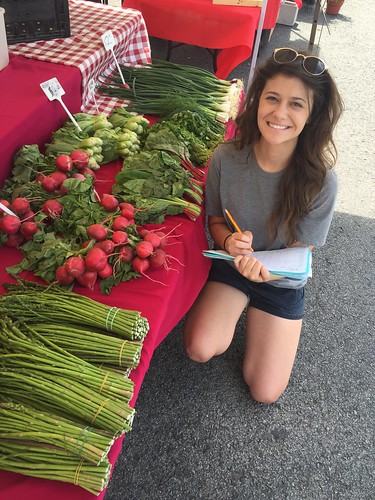Ark Food Innovation Center project aims to help reduce waste, increase slow-month sales for farmers market vendors
May 22, 2018
By Mary Hightower
U of A System Division of Agriculture
Fast facts
- Project buys surplus produce from farmers market vendors
- Surplus to be turned into value-added food products for sale during slow months
- Project funded by specialty crop block grant from Arkansas Ag Department
(743 words)
(Newsrooms – with photos available here: https://flic.kr/s/aHsmcbmsdJ )
Download Word version
FAYETTEVILLE, Ark. – “Waste not, want not,” is at the heart of a project by the University of Arkansas System Division of Agriculture aimed at turning farmers market surplus into foods that can mean sales for farmers and vendors during slow months.
Funded by a specialty crop block grant from the Arkansas Agriculture Department, the project headed by Food Scientist Renee Threlfall will work with The Original Rogers Farmers Market located at the Frisco Station Mall. The market has 80 to 100 vendors that sell fresh vegetables, fruits, baked goods, meats, honey, jams and jellies, eggs, herbs, flowers and other non-food items.
“We are exploring how to turn surplus fruits and vegetables into Arkansas-grown value-added products such as sauces, jellies or jams that could be sold by farmers market vendors or in grocery stores during late fall, winter and early spring when fresh local produce is limited and farmers market sales are slow,” said Threlfall, who is part of the U of A System Division of Agriculture’s Arkansas Food Innovation Center.

Threlfall and two other Division of Agriculture colleagues: Amanda McWhirt, extension fruit and vegetable specialist and Mike Thomsen, professor-agricultural economics, are supervising Morgan Gramlich, a horticulture graduate student, on this project.
Gramlich’s project is to track types and quantities of market produce and surplus, then purchase that surplus produce from the vendors.
“We’re also looking for ‘seconds’ or ‘thirds,’ those ‘ugly’ fruits and vegetables that are safe to use but may not be purchased at the market because their shapes are unappealing to consumers,” she said. This project team will then produce value-added items from the surplus purchased at the market.
The program is seeking produce that can be frozen – keeping it usable for later processing – and include fruits, vegetables and herbs. However, items that don’t freeze well, such as cucumbers and lettuces are not on the collection list.
“Our project team is working to integrate into the market, becoming part of the family of vendors there,” Threlfall said. “Gramlich will be at the market every Saturday and Wednesday this summer working with vendors to explain what we’re trying to accomplish with this project and its implementation.”
“This is a preliminary project to test the feasibility of capturing excess fresh produce and turning it into a product that may enable growers and markets to make extra income,” said McWhirt. “We hope that this preliminary project will help us to evaluate the economics of creating these value-added products and to develop some guidelines for how this idea can be implemented at other farmers markets across the state.”
Fresh from graduation, Gramlich said she is looking forward to putting her undergraduate studies to work.
“I am really excited to get to know members of my community through this project,” she said. “My undergraduate major was horticulture, but this project allows me to apply the material I learned from not only my main area of study, but also my minors. Applying my economics background to horticulture will present a unique and interesting challenge, and I’m more than ready to get started! “
For more information about the Arkansas Food Innovation Center, visit aifc.uark.edu. For more information about the Arkansas Agriculture Department and the Specialty Crop Block Grant program, visit agriculture.arkansas.gov.
About the Division of Agriculture
The University of Arkansas System Division of Agriculture’s mission is to strengthen
agriculture, communities, and families by connecting trusted research to the adoption
of best practices. Through the Agricultural Experiment Station and the Cooperative
Extension Service, the Division of Agriculture conducts research and extension work
within the nation’s historic land grant education system.
The Division of Agriculture is one of 20 entities within the University of Arkansas System. It has offices in all 75 counties in Arkansas and faculty on five system campuses.
Pursuant to 7 CFR § 15.3, the University of Arkansas System Division of Agriculture offers all its Extension and Research programs and services (including employment) without regard to race, color, sex, national origin, religion, age, disability, marital or veteran status, genetic information, sexual preference, pregnancy or any other legally protected status, and is an equal opportunity institution.
# # #
Media Contact: Mary Hightower
Dir. of Communication Services
U of A System Division of Agriculture
Cooperative Extension Service
(501) 671-2126
mhightower@uada.edu